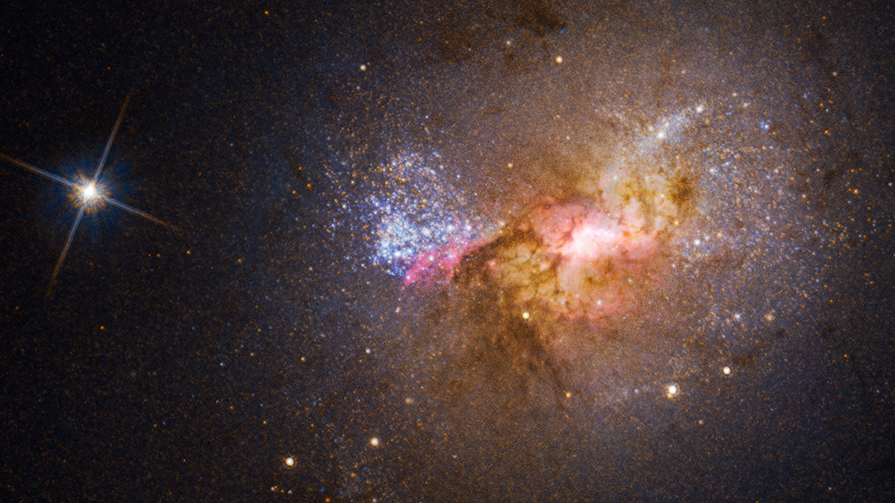
Black holes help stars form?
Astronomers using the Hubble Space Telescope said this week (January 19, 2022) they found new evidence for a massive black hole at the heart of the dwarf galaxy Henize 2-10. And they said this black hole appears to be helping to create new stars. The little galaxy – which lies 30 million light-years away in the direction of the southern constellation Pyxis – contains only about a tenth the number of our Milky Way’s stars. A decade ago, this galaxy set off a debate as to whether something this small could even have a central massive black hole. The new evidence suggests Henize 2-10 does not only have a black hole at its heart, but that the hole is also causing what these astronomers called “a firestorm of new star formation.”
Astronomer Amy Reines at Montana State University published the first evidence for a black hole in Henize 2-10 in 2011. She’s the lead investigator on the new Hubble observations, which were published in the January 19 issue of the peer-reviewed journal Nature. Reines commented:
Ten years ago, as a graduate student, thinking I would spend my career on star formation, I looked at the data from Henize 2-10 and everything changed.
From the beginning I knew something unusual and special was happening in Henize 2-10, and now Hubble has provided a very clear picture of the connection between the black hole and a neighboring star forming region located 230 light-years from the black hole.
That connection is an outflow of gas stretching across space “like an umbilical cord,” these astronomers said, to a bright region of star formation.
The 2022 lunar calendars are here. Order yours before they’re gone!

Like an umbilical cord
These astronomers’ statement explained:
The region was already home to a dense cocoon of gas when the low-velocity outflow arrived. Hubble spectroscopy shows the outflow was moving about 1 million miles per hour (1.6 million km/hr), slamming into the dense gas like a garden hose hitting a pile of dirt and spreading out. Newborn star clusters dot the path of the outflow’s spread, their ages also calculated by Hubble.
This is the opposite effect of what’s seen in larger galaxies, where material falling toward the black hole is whisked away by surrounding magnetic fields, forming blazing jets of plasma moving at close to the speed of light. Gas clouds caught in the jets’ path would be heated far beyond their ability to cool back down and form stars. But with the less-massive black hole in Henize 2-10, and its gentler outflow, gas was compressed just enough to precipitate new star formation.
Zachary Schutte, Reines’ graduate student and lead author of the new study, commented:
At only 30 million light-years away, Henize 2-10 is close enough that Hubble was able to capture both images and spectroscopic evidence of a black hole outflow very clearly. The additional surprise was that, rather than suppressing star formation, the outflow was triggering the birth of new stars.

Black hole or supernova remnant
The data that come to astronomers from the distant universe isn’t always clear cut. And sometimes astronomers disagree on how to interpret the data. That was the case with Henize 2-10, when Reines first began to study it. To Reines, emissions from this dwarf galaxy suggested a massive (but not supermassive) black hole. But other astronomers disagreed. They thought it was more likely the emissions indicated a supernova remnant. That made sense, too, since Henize 2-10 is known as a starburst galaxy. That means it’s undergoing rapid star formation. And galaxies producing stars at a rapid pace would also be producing many hot, massive, blue stars. These sorts of stars evolve quickly and explode quickly as supernovae.
But now Reines said she’s more convinced than ever that the black hole interpretation is correct. She said:
Hubble’s amazing resolution [ability to see clearly] shows a corkscrew-like pattern in the velocities of the gas [coming from the central part of the galaxy]. We can fit that pattern to the computer model of a precessing, or wobbling, outflow from a black hole. A supernova remnant would not have that pattern. And so it is effectively our smoking-gun proof that this is a black hole.
Reines said she expects that even more research will be directed at dwarf galaxy black holes in the future, with the aim of using them as clues to the mystery of how supermassive black holes came to be in the early universe. These astronomers’ statement explained:
It’s a persistent puzzle for astronomers. The relationship between the mass of the galaxy and its black hole can provide clues. The black hole in Henize 2-10 is around 1 million solar masses. In larger galaxies, black holes can be more than 1 billion times our sun’s mass. The more massive the host galaxy, the more massive the central black hole.
Current theories on the origin of supermassive black holes break down into three categories: 1) they formed just like smaller stellar-mass black holes, from the implosion of stars, and somehow gathered enough material to grow supermassive, 2) special conditions in the early universe allowed for the formation of supermassive stars, which collapsed to form massive black hole “seeds” right off the bat, or 3) the seeds of future supermassive black holes were born in dense star clusters, where the cluster’s overall mass would have been enough to somehow create them from gravitational collapse.
So far, none of these black hole seeding theories has taken the lead. Dwarf galaxies like Henize 2-10 offer promising potential clues, because they have remained small over cosmic time, rather than undergoing the growth and mergers of large galaxies like the Milky Way. Astronomers think that dwarf galaxy black holes could serve as an analog for black holes in the early universe, when they were just beginning to form and grow.
Reines concluded:
The era of the first black holes is not something that we have been able to see. So it really has become the big question: where did they come from? Dwarf galaxies may retain some memory of the black hole seeding scenario that has otherwise been lost to time and space.
Bottom line: New data from the heart of the dwarf galaxy Henize 2-10 suggest some black holes help create stars. They also bring new light on how the first supermassive black holes formed.
Source: Black hole triggered star formation in the dwarf galaxy Henize 2-10
The post Black holes devour stars. Do they also help stars form? first appeared on EarthSky.
from EarthSky https://ift.tt/33Ttjio

Black holes help stars form?
Astronomers using the Hubble Space Telescope said this week (January 19, 2022) they found new evidence for a massive black hole at the heart of the dwarf galaxy Henize 2-10. And they said this black hole appears to be helping to create new stars. The little galaxy – which lies 30 million light-years away in the direction of the southern constellation Pyxis – contains only about a tenth the number of our Milky Way’s stars. A decade ago, this galaxy set off a debate as to whether something this small could even have a central massive black hole. The new evidence suggests Henize 2-10 does not only have a black hole at its heart, but that the hole is also causing what these astronomers called “a firestorm of new star formation.”
Astronomer Amy Reines at Montana State University published the first evidence for a black hole in Henize 2-10 in 2011. She’s the lead investigator on the new Hubble observations, which were published in the January 19 issue of the peer-reviewed journal Nature. Reines commented:
Ten years ago, as a graduate student, thinking I would spend my career on star formation, I looked at the data from Henize 2-10 and everything changed.
From the beginning I knew something unusual and special was happening in Henize 2-10, and now Hubble has provided a very clear picture of the connection between the black hole and a neighboring star forming region located 230 light-years from the black hole.
That connection is an outflow of gas stretching across space “like an umbilical cord,” these astronomers said, to a bright region of star formation.
The 2022 lunar calendars are here. Order yours before they’re gone!

Like an umbilical cord
These astronomers’ statement explained:
The region was already home to a dense cocoon of gas when the low-velocity outflow arrived. Hubble spectroscopy shows the outflow was moving about 1 million miles per hour (1.6 million km/hr), slamming into the dense gas like a garden hose hitting a pile of dirt and spreading out. Newborn star clusters dot the path of the outflow’s spread, their ages also calculated by Hubble.
This is the opposite effect of what’s seen in larger galaxies, where material falling toward the black hole is whisked away by surrounding magnetic fields, forming blazing jets of plasma moving at close to the speed of light. Gas clouds caught in the jets’ path would be heated far beyond their ability to cool back down and form stars. But with the less-massive black hole in Henize 2-10, and its gentler outflow, gas was compressed just enough to precipitate new star formation.
Zachary Schutte, Reines’ graduate student and lead author of the new study, commented:
At only 30 million light-years away, Henize 2-10 is close enough that Hubble was able to capture both images and spectroscopic evidence of a black hole outflow very clearly. The additional surprise was that, rather than suppressing star formation, the outflow was triggering the birth of new stars.

Black hole or supernova remnant
The data that come to astronomers from the distant universe isn’t always clear cut. And sometimes astronomers disagree on how to interpret the data. That was the case with Henize 2-10, when Reines first began to study it. To Reines, emissions from this dwarf galaxy suggested a massive (but not supermassive) black hole. But other astronomers disagreed. They thought it was more likely the emissions indicated a supernova remnant. That made sense, too, since Henize 2-10 is known as a starburst galaxy. That means it’s undergoing rapid star formation. And galaxies producing stars at a rapid pace would also be producing many hot, massive, blue stars. These sorts of stars evolve quickly and explode quickly as supernovae.
But now Reines said she’s more convinced than ever that the black hole interpretation is correct. She said:
Hubble’s amazing resolution [ability to see clearly] shows a corkscrew-like pattern in the velocities of the gas [coming from the central part of the galaxy]. We can fit that pattern to the computer model of a precessing, or wobbling, outflow from a black hole. A supernova remnant would not have that pattern. And so it is effectively our smoking-gun proof that this is a black hole.
Reines said she expects that even more research will be directed at dwarf galaxy black holes in the future, with the aim of using them as clues to the mystery of how supermassive black holes came to be in the early universe. These astronomers’ statement explained:
It’s a persistent puzzle for astronomers. The relationship between the mass of the galaxy and its black hole can provide clues. The black hole in Henize 2-10 is around 1 million solar masses. In larger galaxies, black holes can be more than 1 billion times our sun’s mass. The more massive the host galaxy, the more massive the central black hole.
Current theories on the origin of supermassive black holes break down into three categories: 1) they formed just like smaller stellar-mass black holes, from the implosion of stars, and somehow gathered enough material to grow supermassive, 2) special conditions in the early universe allowed for the formation of supermassive stars, which collapsed to form massive black hole “seeds” right off the bat, or 3) the seeds of future supermassive black holes were born in dense star clusters, where the cluster’s overall mass would have been enough to somehow create them from gravitational collapse.
So far, none of these black hole seeding theories has taken the lead. Dwarf galaxies like Henize 2-10 offer promising potential clues, because they have remained small over cosmic time, rather than undergoing the growth and mergers of large galaxies like the Milky Way. Astronomers think that dwarf galaxy black holes could serve as an analog for black holes in the early universe, when they were just beginning to form and grow.
Reines concluded:
The era of the first black holes is not something that we have been able to see. So it really has become the big question: where did they come from? Dwarf galaxies may retain some memory of the black hole seeding scenario that has otherwise been lost to time and space.
Bottom line: New data from the heart of the dwarf galaxy Henize 2-10 suggest some black holes help create stars. They also bring new light on how the first supermassive black holes formed.
Source: Black hole triggered star formation in the dwarf galaxy Henize 2-10
The post Black holes devour stars. Do they also help stars form? first appeared on EarthSky.
from EarthSky https://ift.tt/33Ttjio

Aucun commentaire:
Enregistrer un commentaire